Consequences of shipping to the United States without the "made in China" label
- Author:MIKEY
- Source:Sunny Worldwide Logistics
- Release Date:2019-12-07
A reminder from an unlucky consignor:
Dozens of tickets were sent to the United States this year
Finally overturned
The product is not labeled with made in china
The agent sent thousands of tickets to the United States this year, and I was the first to be detained. . .
I stayed up until 3 o'clock yesterday and followed the communication process between the customer and customs and ups.
The result is still the same, returned or destroyed
Do not allow supplementary tags
Tens of thousands of dollars have been thrown away like this. The returned freight and tariffs have exceeded the value of the goods, so 90% will be destroyed.
The lesson of blood, here is a reminder to the majority of consignors: Goods going to the United States must have a made in China label on each product. Don't be lucky, in fact, the policy was in place last year. It ’s just that there are fewer deductions, and there are at most warnings, so many consignors, like me, do n’t care about him, just think that there is made in china on the box.
The Fuyou posted a post asking for help, thank you for the lessons he bought at a high price, and share it with you and me.
Why should we label "MADE IN CHINA"?
It is common sense to affix the label of origin, and the products of normal foreign trade must be written in the origin. Customs has always had this requirement, and US customs clearance has always had this requirement, except that the inspection is often tight and loose. Therefore, for a period of time, the goods that have not been affixed to MADE IN CHINA have enjoyed a very good time-effective receipt. That is because the customs has not inspected them, so there is no problem.
If the customs inspects the goods without the “MADE IN CHINA” label, it may lead to customs detention, delay in the time limit originally promised to the customer, and cause unnecessary losses to the customer.
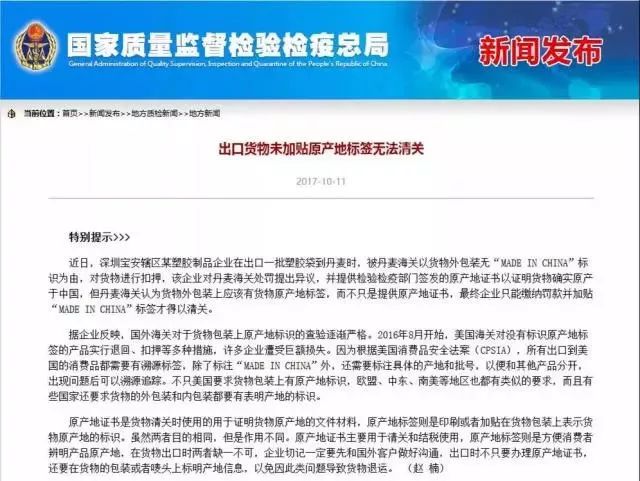
Figure | General Administration of Quality Supervision, Inspection and Quarantine issued a reminder on "Export goods cannot be cleared without the label of origin"
Case:
A plastic product company in Shenzhen exported a batch of plastic bags to Denmark in 2017, but was detained by Danish customs. The reason given by Danish Customs is that there is no "MADE IN CHINA" logo on the outer packaging of the goods. The company expressed dissatisfaction and provided the certificate of origin issued by the inspection and quarantine department. However, Danish Customs said that the certificate belongs to the certificate and the label belongs to the label. The label must be present. In the end, the company could only pay the fine and attach the "MADE IN CHINA" label to complete the customs clearance.
开始 Beginning in August 2016, U.S. Customs implemented various measures such as return and seizure of products that did not identify the origin label, and many enterprises suffered huge losses. Not only does the United States require a mark of origin on the packaging of the goods, but the European Union, the Middle East, and South America also have similar requirements, and some countries also require that the outer and inner packagings of the goods have a mark indicating the origin.
For products entering the US market, the US Customs requires the origin of the product to be marked on the product. If it is produced in China, it is required to be labeled "MADE IN CHINA" on the product. Here is a special reminder. Products must be labeled "MADE IN CHINA". Generally speaking, most sellers will mark MADE IN CHINA on the product's SKU barcode.
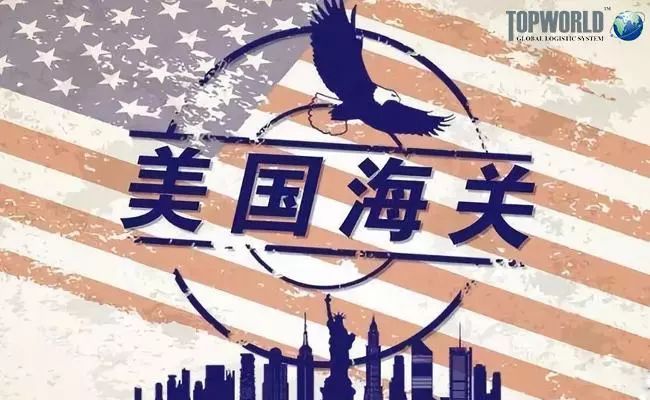
According to informed consignees, US Customs not only scrutinizes the certificate of origin, especially at the two customs, EWR (Newark Liberty International Airport) and SFO (San Francisco International Airport, California). Test report) and CHILDREN PRODUCT CERTIFICATE. Strictly investigate all products related to children (such as children's toys, children's clothing, etc.), may be temporarily detained. If you have related products to the United States recently, please confirm whether you have these two materials.
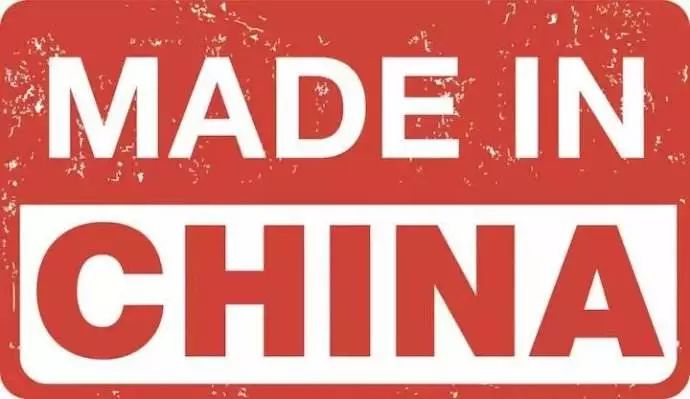
In fact, starting in August 2016, US Customs implemented various measures such as return and seizure of products that did not identify the origin label, and many enterprises suffered huge losses.
According to the US Consumer Product Safety Act (CPSIA), all consumer products exported to the United States need to have two traceability labels:
Mark "MADE IN CHINA";
Mark the specific place of origin and batch number so as to be separated from other products, and trace back to the source when a problem occurs.
The label of origin must be in English. It must be obvious and easy to identify. The method of labeling the label of origin must be reasonable and meet US customs standards. The customs at the Los Angeles Port of the United States is particularly strict, and there are often customs deductions for non-compliant shipments. Once detained due to the problem of origin labeling, there are only two ways to deal with it: return or destroy.
Specific requirements for labeling "MADE IN CHINA"
Therefore, the labeling is completely to avoid the extra cost and time delay caused by the deduction or return of the goods. Please operate the seller according to the following requirements:
1. Whether you go to Amazon warehouse, overseas warehouse, private address, you need to paste it;
2. Whether it is express delivery or dedicated line, it needs to be posted;
3. Both the product and the outer box need to be affixed. Customers are advised to mark MADE IN CHINA together when they barcode the SKU products.
Is there any requirement for Amazon FBA product packaging? In fact, as sellers know that Amazon has very strict packaging requirements for products, especially in terms of labels (here involving SKU labels and Made in China).
1.National standard
The national standard is generally a square with a side length of 4CM. FBA products need to stick two national standards on the upper right corner of the narrow side of each box.
2. Product SKU label
The SKU label of a product is the unique identification of a product. Amazon does not recognize the code. So be sure to check carefully to avoid posting mistakes. Once the SKU code is posted incorrectly, it will be very expensive for Amazon to replace it for you.
3.FBA Label
The FBA Label is the outer box identification of the goods at the Amazon warehouse. It is affixed to the product's packaging, because this is a proof of identity of the product, so it is relied on this when entering and leaving the warehouse.
4.Made in China label
Products exported to the United States must be labeled Made in China. The outer box and each product must be labeled "MADE IN CHINA", otherwise it will be detained and returned by local customs.
5.Overweight tags
Amazon stipulates that a single box of parcels cannot exceed 30 kg. If a single box of parcels exceeds 15 kg, a "Team Lift" label is required. Because of Amazon cargo handling regulations, packages weighing more than 15 kg require two operators to operate. The "Team Lift" label is provided to remind the operator that two people are required to operate it.
United States-According to the US Consumer Product Safety Act (CPSIA), all consumer products exported to the United States need to have 2 traceable labels:
Mark "MADE IN CHINA"; mark the specific origin and batch number so as to be separated from other products, and trace back to the source if there is a problem.
The label of origin must be in English. It must be obvious and easy to identify. The method of labeling the label of origin must be reasonable and meet US customs standards. The customs at the Los Angeles Port of the United States is particularly strict, and there are often customs deductions for non-compliant shipments. Once detained due to the problem of origin labeling, there are only two ways to deal with it: return or destroy.
One company exported to the United States, but the result was also returned by the US Customs because it did not have the "Made in China" label! Not to mention the loss of transportation costs, and the delivery time has been seriously delayed!
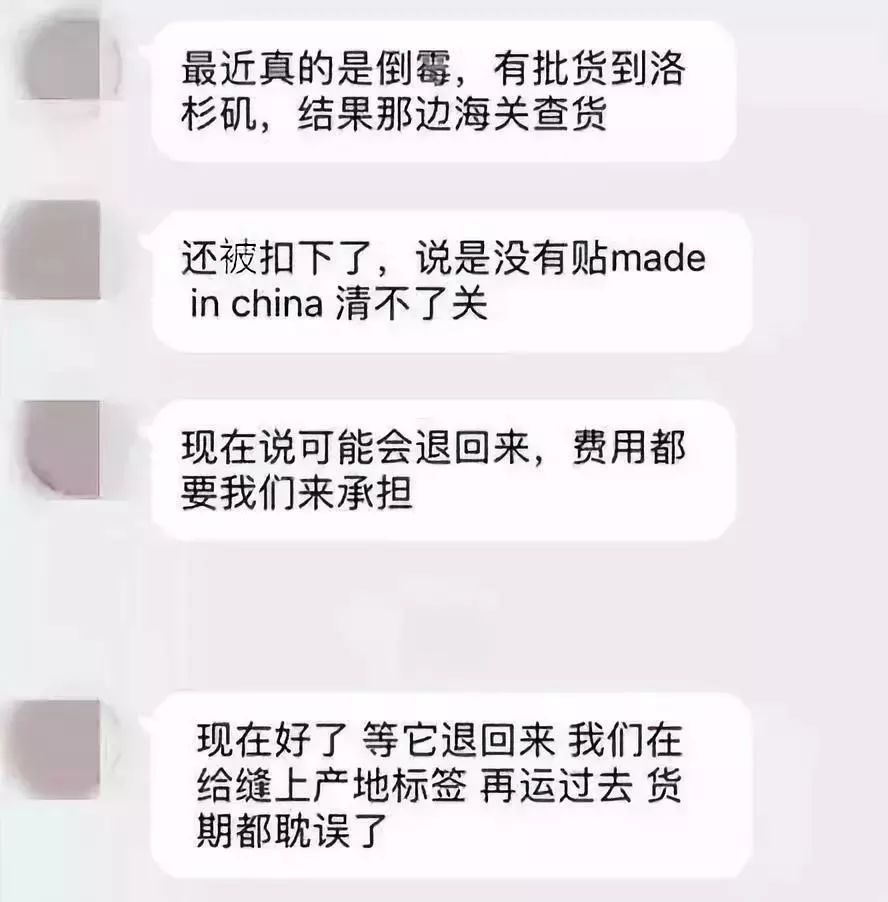
EU-In order to strengthen the current consumer product regulatory framework and consumer product safety, the European Commission proposed a series of legislative proposals on product safety and market surveillance issues on February 13, 2013. Under the bill, manufacturers or importers must ensure that all products sold in the EU, whether or not they come from the EU, indicate the origin of the product. If the product cannot be marked with the country of origin due to its size and / or nature, the country of origin must be marked on the packaging or attached documents. For products manufactured in a member state of the European Union, the country of origin label can indicate that the product's country of origin is the European Union or the member state. In addition, the draft product safety regulation also requires that all products sold in the European Union must provide the name and address of the manufacturer.
In terms of textiles, the European Union (EU) No. 1007/2011 implemented on May 8, 2012 stipulates that the label of the textile product must correctly indicate the country of origin, and the spinning, weaving, finishing or sewing of a textile At least two links in the manufacturing process are produced in the EU before they can be considered as textiles originating in EU countries. For products imported from a third country, an origin label should be mandatory.
In terms of furniture, the EU ’s “Label of Origin Labeling Law”, which entered into force on March 3, 2011, requires that wood products imported into the EU market must obtain an FSC “ID card”, which proves that the wood purchased by the production company is produced in a legally developed forest. Furniture produced from wood without an “ID” cannot be exported to the EU.
Saudi Arabia-Let's talk about another case. A company in Ningbo shipped to Saudi Arabia and labeled the country of origin, but it was still shipped! what happened? Because this company uses a sticker label, Saudi Arabia stipulates that the label of origin "needs to be marked by inscription or non-erasable printing"!
Saudi Arabia stipulates that, from February 1, 2009, for all imported goods arriving in Saudi Arabia, the country of origin (Country of Origin / Made in…) of the imported goods must be engraved in a way that cannot be removed by marking or stickers. On all goods. The outer box / carton must also be printed with the country of origin. If the goods carry a dual origin identification or misleading consumer information, the goods will be transferred to the legal department of Saudi customs authorities.
The details of the Certificate of Origin (CO) must also be consistent.
In addition, please note that all goods imported to the local area for exhibition purposes must be accompanied by a certificate of origin and invoice. The invoice must indicate the value of the product, and the relevant amount must be approved by the endorsement of the chamber of commerce of the exporting country. The invoice must clearly show that the goods are for display purposes only and will be re-exported. The Saudi customs will charge a deposit for these goods, and the deposit will be refunded in the future.
South American countries-South American countries also have mandatory requirements for appellations of origin. Previously, there was a foreign trade company exporting to Chile. Because it forgot to stick the label of origin, it was found by the local customs and was fined $ 4,000!
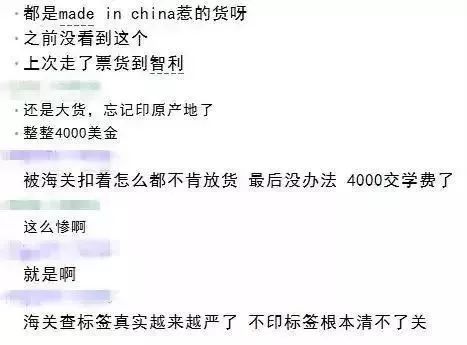
The friend who exported to Chile ate unlabeled losses.
Another example is Argentina. Argentina ’s general rules on origin labeling: if a product has any mark, the origin label should also appear in a conspicuous position; for example, the container, packaging or main label of the product clearly indicates the origin . However, if the primary label is too small to indicate the country of origin, an additional label is required to indicate the country of origin. The label should be on the same side as the main label on the container.
★ reminder ★
The certificate of origin is the documentary materials used to prove the origin of the goods when the goods are cleared. The label of origin is a mark that is printed or affixed to the goods packaging to indicate the origin of the goods. Although they serve the same purpose, they serve different purposes. The certificate of origin is mainly used for customs clearance and tax settlement. The label of origin is convenient for consumers to identify the origin of the product. Both are indispensable when the goods are exported. Enterprises must remember to communicate with foreign customers first. As long as the certificate of origin is obtained, the information of the origin must be marked on the packaging or buns of the goods to avoid the return of the goods due to such problems.
(This article is published by the FOB Foreign Trade Forum, Zhejiang Foreign Trade, and the historical articles of Haiyang.com)
Dozens of tickets were sent to the United States this year
Finally overturned
The product is not labeled with made in china
The agent sent thousands of tickets to the United States this year, and I was the first to be detained. . .
I stayed up until 3 o'clock yesterday and followed the communication process between the customer and customs and ups.
The result is still the same, returned or destroyed
Do not allow supplementary tags
Tens of thousands of dollars have been thrown away like this. The returned freight and tariffs have exceeded the value of the goods, so 90% will be destroyed.
The lesson of blood, here is a reminder to the majority of consignors: Goods going to the United States must have a made in China label on each product. Don't be lucky, in fact, the policy was in place last year. It ’s just that there are fewer deductions, and there are at most warnings, so many consignors, like me, do n’t care about him, just think that there is made in china on the box.
The Fuyou posted a post asking for help, thank you for the lessons he bought at a high price, and share it with you and me.
Why should we label "MADE IN CHINA"?
It is common sense to affix the label of origin, and the products of normal foreign trade must be written in the origin. Customs has always had this requirement, and US customs clearance has always had this requirement, except that the inspection is often tight and loose. Therefore, for a period of time, the goods that have not been affixed to MADE IN CHINA have enjoyed a very good time-effective receipt. That is because the customs has not inspected them, so there is no problem.
If the customs inspects the goods without the “MADE IN CHINA” label, it may lead to customs detention, delay in the time limit originally promised to the customer, and cause unnecessary losses to the customer.

Figure | General Administration of Quality Supervision, Inspection and Quarantine issued a reminder on "Export goods cannot be cleared without the label of origin"
Case:
A plastic product company in Shenzhen exported a batch of plastic bags to Denmark in 2017, but was detained by Danish customs. The reason given by Danish Customs is that there is no "MADE IN CHINA" logo on the outer packaging of the goods. The company expressed dissatisfaction and provided the certificate of origin issued by the inspection and quarantine department. However, Danish Customs said that the certificate belongs to the certificate and the label belongs to the label. The label must be present. In the end, the company could only pay the fine and attach the "MADE IN CHINA" label to complete the customs clearance.
开始 Beginning in August 2016, U.S. Customs implemented various measures such as return and seizure of products that did not identify the origin label, and many enterprises suffered huge losses. Not only does the United States require a mark of origin on the packaging of the goods, but the European Union, the Middle East, and South America also have similar requirements, and some countries also require that the outer and inner packagings of the goods have a mark indicating the origin.
For products entering the US market, the US Customs requires the origin of the product to be marked on the product. If it is produced in China, it is required to be labeled "MADE IN CHINA" on the product. Here is a special reminder. Products must be labeled "MADE IN CHINA". Generally speaking, most sellers will mark MADE IN CHINA on the product's SKU barcode.

According to informed consignees, US Customs not only scrutinizes the certificate of origin, especially at the two customs, EWR (Newark Liberty International Airport) and SFO (San Francisco International Airport, California). Test report) and CHILDREN PRODUCT CERTIFICATE. Strictly investigate all products related to children (such as children's toys, children's clothing, etc.), may be temporarily detained. If you have related products to the United States recently, please confirm whether you have these two materials.

In fact, starting in August 2016, US Customs implemented various measures such as return and seizure of products that did not identify the origin label, and many enterprises suffered huge losses.
According to the US Consumer Product Safety Act (CPSIA), all consumer products exported to the United States need to have two traceability labels:
Mark "MADE IN CHINA";
Mark the specific place of origin and batch number so as to be separated from other products, and trace back to the source when a problem occurs.
The label of origin must be in English. It must be obvious and easy to identify. The method of labeling the label of origin must be reasonable and meet US customs standards. The customs at the Los Angeles Port of the United States is particularly strict, and there are often customs deductions for non-compliant shipments. Once detained due to the problem of origin labeling, there are only two ways to deal with it: return or destroy.
Specific requirements for labeling "MADE IN CHINA"
Therefore, the labeling is completely to avoid the extra cost and time delay caused by the deduction or return of the goods. Please operate the seller according to the following requirements:
1. Whether you go to Amazon warehouse, overseas warehouse, private address, you need to paste it;
2. Whether it is express delivery or dedicated line, it needs to be posted;
3. Both the product and the outer box need to be affixed. Customers are advised to mark MADE IN CHINA together when they barcode the SKU products.
Is there any requirement for Amazon FBA product packaging? In fact, as sellers know that Amazon has very strict packaging requirements for products, especially in terms of labels (here involving SKU labels and Made in China).
1.National standard
The national standard is generally a square with a side length of 4CM. FBA products need to stick two national standards on the upper right corner of the narrow side of each box.
2. Product SKU label
The SKU label of a product is the unique identification of a product. Amazon does not recognize the code. So be sure to check carefully to avoid posting mistakes. Once the SKU code is posted incorrectly, it will be very expensive for Amazon to replace it for you.
3.FBA Label
The FBA Label is the outer box identification of the goods at the Amazon warehouse. It is affixed to the product's packaging, because this is a proof of identity of the product, so it is relied on this when entering and leaving the warehouse.
4.Made in China label
Products exported to the United States must be labeled Made in China. The outer box and each product must be labeled "MADE IN CHINA", otherwise it will be detained and returned by local customs.
5.Overweight tags
Amazon stipulates that a single box of parcels cannot exceed 30 kg. If a single box of parcels exceeds 15 kg, a "Team Lift" label is required. Because of Amazon cargo handling regulations, packages weighing more than 15 kg require two operators to operate. The "Team Lift" label is provided to remind the operator that two people are required to operate it.
United States-According to the US Consumer Product Safety Act (CPSIA), all consumer products exported to the United States need to have 2 traceable labels:
Mark "MADE IN CHINA"; mark the specific origin and batch number so as to be separated from other products, and trace back to the source if there is a problem.
The label of origin must be in English. It must be obvious and easy to identify. The method of labeling the label of origin must be reasonable and meet US customs standards. The customs at the Los Angeles Port of the United States is particularly strict, and there are often customs deductions for non-compliant shipments. Once detained due to the problem of origin labeling, there are only two ways to deal with it: return or destroy.
One company exported to the United States, but the result was also returned by the US Customs because it did not have the "Made in China" label! Not to mention the loss of transportation costs, and the delivery time has been seriously delayed!

EU-In order to strengthen the current consumer product regulatory framework and consumer product safety, the European Commission proposed a series of legislative proposals on product safety and market surveillance issues on February 13, 2013. Under the bill, manufacturers or importers must ensure that all products sold in the EU, whether or not they come from the EU, indicate the origin of the product. If the product cannot be marked with the country of origin due to its size and / or nature, the country of origin must be marked on the packaging or attached documents. For products manufactured in a member state of the European Union, the country of origin label can indicate that the product's country of origin is the European Union or the member state. In addition, the draft product safety regulation also requires that all products sold in the European Union must provide the name and address of the manufacturer.
In terms of textiles, the European Union (EU) No. 1007/2011 implemented on May 8, 2012 stipulates that the label of the textile product must correctly indicate the country of origin, and the spinning, weaving, finishing or sewing of a textile At least two links in the manufacturing process are produced in the EU before they can be considered as textiles originating in EU countries. For products imported from a third country, an origin label should be mandatory.
In terms of furniture, the EU ’s “Label of Origin Labeling Law”, which entered into force on March 3, 2011, requires that wood products imported into the EU market must obtain an FSC “ID card”, which proves that the wood purchased by the production company is produced in a legally developed forest. Furniture produced from wood without an “ID” cannot be exported to the EU.
Saudi Arabia-Let's talk about another case. A company in Ningbo shipped to Saudi Arabia and labeled the country of origin, but it was still shipped! what happened? Because this company uses a sticker label, Saudi Arabia stipulates that the label of origin "needs to be marked by inscription or non-erasable printing"!
Saudi Arabia stipulates that, from February 1, 2009, for all imported goods arriving in Saudi Arabia, the country of origin (Country of Origin / Made in…) of the imported goods must be engraved in a way that cannot be removed by marking or stickers. On all goods. The outer box / carton must also be printed with the country of origin. If the goods carry a dual origin identification or misleading consumer information, the goods will be transferred to the legal department of Saudi customs authorities.
The details of the Certificate of Origin (CO) must also be consistent.
In addition, please note that all goods imported to the local area for exhibition purposes must be accompanied by a certificate of origin and invoice. The invoice must indicate the value of the product, and the relevant amount must be approved by the endorsement of the chamber of commerce of the exporting country. The invoice must clearly show that the goods are for display purposes only and will be re-exported. The Saudi customs will charge a deposit for these goods, and the deposit will be refunded in the future.
South American countries-South American countries also have mandatory requirements for appellations of origin. Previously, there was a foreign trade company exporting to Chile. Because it forgot to stick the label of origin, it was found by the local customs and was fined $ 4,000!

The friend who exported to Chile ate unlabeled losses.
Another example is Argentina. Argentina ’s general rules on origin labeling: if a product has any mark, the origin label should also appear in a conspicuous position; for example, the container, packaging or main label of the product clearly indicates the origin . However, if the primary label is too small to indicate the country of origin, an additional label is required to indicate the country of origin. The label should be on the same side as the main label on the container.
★ reminder ★
The certificate of origin is the documentary materials used to prove the origin of the goods when the goods are cleared. The label of origin is a mark that is printed or affixed to the goods packaging to indicate the origin of the goods. Although they serve the same purpose, they serve different purposes. The certificate of origin is mainly used for customs clearance and tax settlement. The label of origin is convenient for consumers to identify the origin of the product. Both are indispensable when the goods are exported. Enterprises must remember to communicate with foreign customers first. As long as the certificate of origin is obtained, the information of the origin must be marked on the packaging or buns of the goods to avoid the return of the goods due to such problems.
(This article is published by the FOB Foreign Trade Forum, Zhejiang Foreign Trade, and the historical articles of Haiyang.com)
